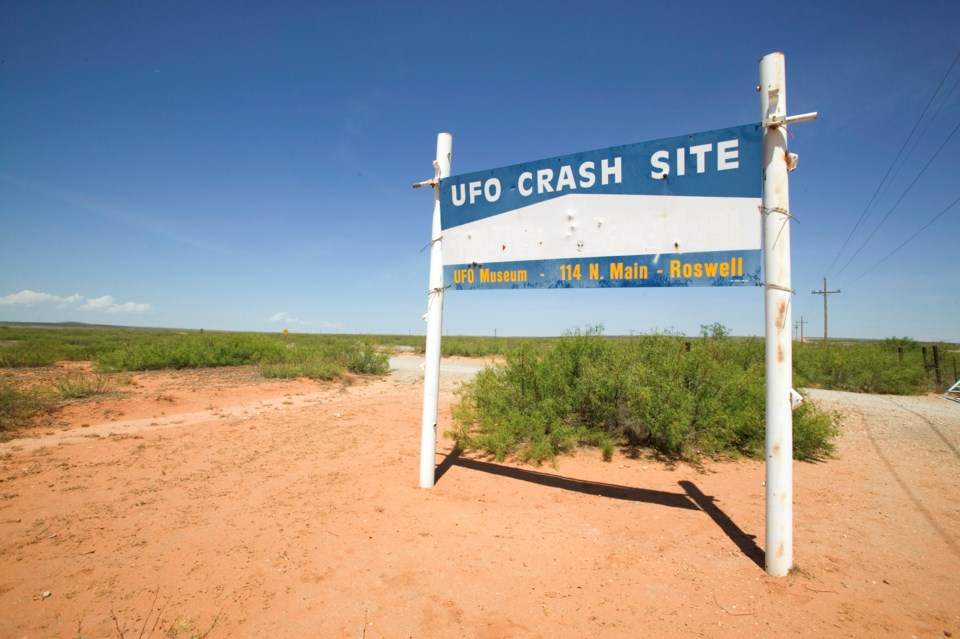For decades, the mere mention of UFOs would conjure images of flying saucers and little green men. But at some point in the last few years, U.S. officials have gotten over the punchline, heralding something of a golden age for UFO research.
In 2017, a New York Times bombshell confirmed the existence of a secret program at the Pentagon that had, for years, investigated reports of unidentified flying objects. Officials with the program studied videos of encounters between unknown objects and American military, including one from 2004 that has since been leaked to the public showing a white oval object, about the size of a commercial plane, being followed by a pair of Navy fighter jets off the coast of San Diego. In it, the Tic-Tac-shaped aircraft appears to “bounce around like a Ping-Pong ball,” with no visible wings or means of propulsion, wrote reporter Gideon Lewis-Krauss in a recent New Yorker piece. Then, just last month, the Pentagon confirmed the authenticity of a number of leaked videos and images of supposed UFOs (although officials stopped short of labelling the objects as “unidentified aerial phenomena,” the military’s preferred nomenclature), including one of the more puzzling clips to be released yet. Recorded in 2019 from the deck of the USS Russell, a Navy destroyer that was also stationed off the coast of San Diego, the night-vision footage appears to show several unidentified flying triangles “flashing” in the clouds before merging.
For an institution as opaque and buttoned-down as the U.S. freakin’ military to acknowledge the existence of UFOs is a pretty big deal. For better or worse, UFOs have officially gone mainstream, no longer the exclusive domain of tinfoil-wearing crackpots and conspiracy theorists. And for good reason. Unexplained aerial phenomenon may capture the imagination of alien chasers, but they could represent a far greater threat if linked to foreign adversaries. Although, in more grist for the extraterrestrial mill, several high-ranking security officials believe it virtually impossible for any foreign power to possess technology as advanced as the unidentified objects observed by military personnel. “When we talk about sightings,” former National Intelligence director John Ratcliffe told the Washington Post, “we are talking about objects … that frankly engage in actions that are difficult to explain, movements that are hard to replicate, that we don’t have the technology for, or are travelling at speeds that exceed the sound barrier without a sonic boom.” Freaky stuff.
Donald Trump, for all his flaws, probably did more to advance the public disclosure of UFO phenomenon than any U.S. president in recent memory. Buried in last year’s 5,500-page, US$2.3-trillion appropriations bill that provided millions in coronavirus relief aid was a bizarre provision mandating a report, expected next month, detailing everything the government knows about UFOs.
Needless to say, whatever the origin of these unexplained aircraft, it’s not the kind of thing that governments can simply ignore. So what about Canada, where UFO sightings have risen by as much as 50 per cent in the pandemic? Thanks to the work of Vice reporter Daniel Otis, this month we got official proof that the Canadian military is documenting unexplained aerial phenomenon, thanks to an unclassified intelligence report from January 2019 of a medical transport flight crew that reported “an inexplicable bright light followed them … at the same altitude and speed” over northern Manitoba.
Otis has since combed through thousands of reports in a government flight incident database, honing in on dozens of recent UFO sightings from both Canadian and international airlines. The Civil Aviation Daily Occurrence Report System, a publicly searchable archive operated by Transport Canada, contains nearly 300,000 aviation incident reports over three decades. It’s the most readily available—albeit enigmatic—window we have into UFO sightings in Canadian airspace, but, at least at this point, officials have had little to say on them, which is troubling to experts in the field.
“It concerns me that there is so much secrecy around this,” professor Timothy Sayle from the University of Toronto’s International Relations program told Vice.
With the help of aviation experts, Otis was able to explain away many of the sightings, but there remains a handful that defy easy answers, like a Kalitta Charters Boeing 747 cargo flight that reported an object “flying sporadically” and travelling as fast as Mach 4, beyond the capabilities of modern aircraft, over the Northwest Territories in 2018, or the close call from 2015 when a Porter Airlines plane flying over Lake Ontario was forced to dive out of the way of an unidentified object, injuring two crew members.
For decades now, UFOs have been treated as something of a joke, and it was only through the efforts of a handful of U.S. officials and dogged reporters that the subject is finally being taken seriously in a public way. Given the security implications, it would behoove Canada to do the same, even if it turns out, to my dismay, that these unexplained phenomenon aren’t the product of an army of little green men. Until then, all we can do is look up and wonder.



